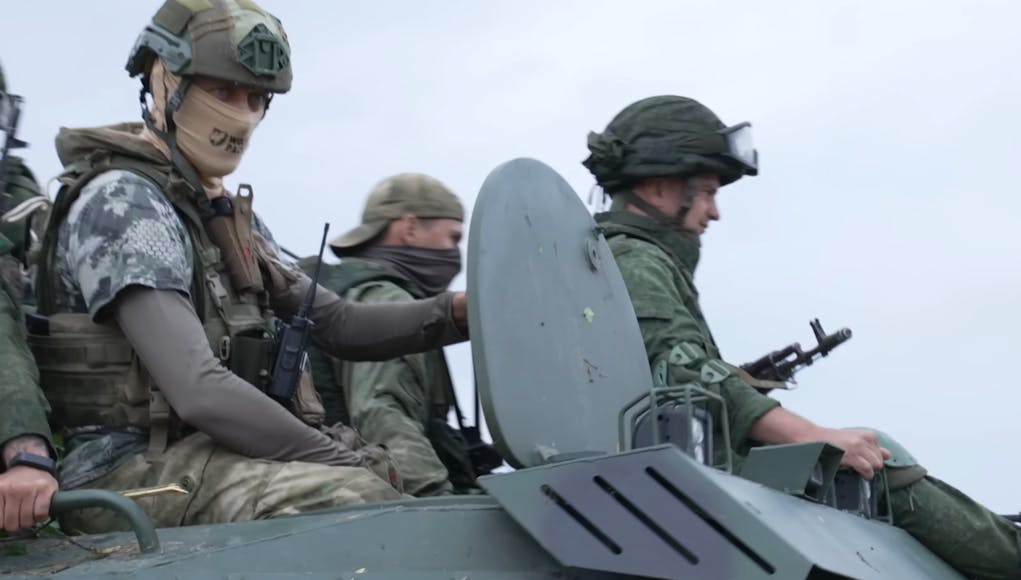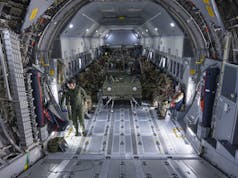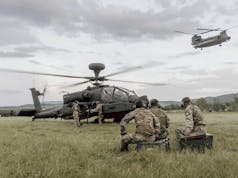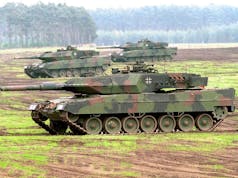With the return of large scale interstate conflict to the European Continent, a key observation has been the widespread employment of surrogate and proxy forces in both conventional and irregular roles.
This article is the opinion of the authors and not necessarily that of the UK Defence Journal. If you would like to submit your own article on this topic or any other, please see our submission guidelines.
These developments bring several questions to the fire, which are key to understanding the future role of such forces in conflicts to come:
- How do surrogate and proxy forces differ in character and purpose?
- What roles have surrogate and proxy forces played in the War in Ukraine?
- In light of the War in Ukraine and the Wagner mutiny, how might these types of forces be employed in conflicts to come?
Both surrogate and proxy forces conduct operations on behalf of an external actor whilst receiving direct and indirect support from said benefactor. The difference lies in their political and geographical ties to the area in which they operate, with proxy forces being tied to the local area, and surrogate forces having no political and geographical ties to the area of operation.
This lack of geographical and political ties allows surrogate forces such as the Russian PMCs deployed in Ukraine (such as Wagner, Moran, Orel, and RUS-Group) a greater level of flexibility, and a wider range of areas and roles in which they can be deployed.
In this case the comparison is to the militias of the Luhansk and Donetsk People’s Republics, which whilst deployable in their respective regions, do not share the same level of flexibility as surrogate forces.
The role of Russian PMCs in the War in Ukraine clearly exemplifies their difference to Western PMCs, undertaking a wide range of front-line combat roles, where Western PMCs usually undertake supporting missions such as convoy and personnel protection.
Russian surrogate forces were instrumental in the initial annexation of Crimea and supporting the secession of parts of the Luhansk and Donetsk regions, allegedly constituting part of the force of ‘little green men’ – the infamous unmarked troops tasked with seizing key areas and infrastructure.
There is no doubt that outside observers will be looking to the ongoing conflict in Ukraine for lessons learned in wide range of areas. Regarding surrogate forces in particular, whilst they have been widely used in a range of scenarios, the Wagner mutiny will make many observers wary of the potential dangers of these forces.
This may lead to more risk averse actors avoiding the use of these forces in the future altogether, whilst others may use them in a more limited way, significantly restricting freedom of action of concentration of power and authority. Whilst the Wagner mutiny may have come as a cautionary tale, it would be short-sighted to say that the use of surrogate forces has been an anomaly.
Given their flexibility and deniability, it is likely that they will remain a key element of hybrid competition in the future.
Image Информационное агентство БелТА, CC BY 3.0, via Wikimedia Commons.













Yes mercenaries have been hired out for millennia with mixed results!
Good example of that was at the Battle of Crecy in the hundred years war
The French hired 5,000 Genoese crossbowmen to take on the English and Welsh longbow archers
Result because of poor logistics and damp crossbows was disastrous for them (Our archers kept their bow strings dry) They were forced to retreat after being decimated and the French didn’t like that and slaughtered the rest to a man
Battle of Waterloo , only 24,000 British troops, rest were mercenaries from various countries.
Hi Peter
Not sure the Prussians and Dutch would agree they were mercenaries but point taken.
The British government paid vast sums to keep the Austrian Empire in that war and the French kept beating them – Austerlitz etc
Get the ragheads to join in.
Did HMG pay Blucher’s Prussian cavalry?
State sponsored surrogate forces and regional proxy forces have been around for ever..infact the British have probably used them to greatest effect..most scattered empires have used them to one degree or another through history. The British east India company had around 260,000 men under arms at its hight and was twice the size of the British army..it effectively ruled and conquered India on behave of the British government.
the Soviet Union and west effectively fought an almost 50 year long global low intensity conflict ( not so low intensity some times) using the concept of proxy’s …infact the reality of the Cold War was a global conflict in which the two protagonists never formally went to war..but were infact at war the entire time using proxies against each other.
So long as people are willing to take on someone else’s fight and others are willing to pay for their services this will probably continue.
How much longer Russia can afford to keep paying them may become an issue. The economy is in the toilet and all it will take is a big flush to push it over the edge.
life expectancy for males in russia 66yrs, life is cheap
Or down the drain….big flushes usually push it down the drain…..you don’t want it going over the edge…very messy.
Eh, I’ll disagree with “A sign of things to come.” PMC’s have been in frequent use for the last two decades, and while Western Nations haven’t used PMC’s in frontline roles per say (eeeeeehhhhhhhh…..) others have for a long time now.
So more a “Sign of the way things are.” IMO.
I can’t see any merc or contracted soldier standing up against a “blood and soil” motivated defence force. The risk/reward calculation just isn’t in their favour. It was perhaps skewed in the Wagner assault on Bakhmut by the extensive use of convicts facing return to a brutal prison system.
Wagner used convicts in a very specific role, the core of Wagner remained it’s volunteer forces, and by all accounts, both Ukranian and Russian, the Wagner Mercenary Core fought much better than the Russian “blood and soil” force and even better than a lot of the Ukranian forces.
Robert Clark, who served in the Army and was involved in combat campaigns in Iraq and Afghanistan, has written a very good piece in yesterday’s Telegraph. Concerning the need for motivation and good morale among attacking forces.
The UkR Army is doing brilliantly against the Russians and reflects confidence among their troops in their officers
https://www.telegraph.co.uk/news/2023/10/24/russia-morale-shtorm-suicide-attack-uk-intelligence-ukraine/
Worth a read
It’s behind a paywall, but I doubt I’d disagree with anything in it from your synopsis. But I also think (sort of reading between the lines of your comment) that it doesn’t discredit the idea that Wagner where highly motivated and better trained and led than the average Russian Army unit. At least their core Pre-War forces that is, since there was a considerable gap between the Wagner veteran forces that they brought in from previous operations and the Conscripts they recruited to fill the numbers (and they literally did use conscripts as recce by death for their actual assault units)
The Ukranians are doing well but as I said, even they stated that the Wagner professional core where as good, if not better, than some of the best units they put into Bakhmut. Another reason to be happy that Pierogi and Putin fell out and that Wagner is a thing of the past. Doesn’t matter how good your troops are if your Generals are back biting and trying to make each other look bad.
Disable javascript and cookies on your browser and you can get in and read it
Plenty examples of very highly motivated and effective mercenary forces across the history of conflict.. the Gurkhas are a fine example of this..
How was it the Gurkhas became part of the British army…it’s all about surrogate forces and mercenaries:
The first real contact with British forces and the Gurkhas was in the Gurkhas war 1814-16 in which the east India company ( a UK surrogate force..of mixed European and Indian mercenary forces) and the kingdom of Nepal, during this war the east India company recruited a number of defectors and formed two battalions of Gurkhas..due to the fighting prowess of the Nepalese forces the east India company continued to recruit Gurkhas from Nepal as part of the east India company..these Gurkhas battalions were then transferred to the British army at the dissolution of the east India company’s by the British government in 1874.
Another group of mercenaries..the 10,000 forged a legend that has lasted 2500 years.
The Swiss guard, more than 1 million Swiss pole arm troops served across European between the 15c to 19c…they were considered the best infantry on the battlefield..off these 200 have been contracted to protect the pope since 1503.
The flying tigers…100 American contract pilots who downed 292 Japanese aircraft….fighting in China before the U.S. joined the Second World War.
The Varangian guard…the most elite unit in the armies of the Byzantine empire, trusted to protect the Emperors of Byzantium and over hundreds of years these Northern European mercenaries were consider the elite strike force of the Byzantine armies.
William Walker an American mercenary led some the very interesting campaigns in the Americas..infact the U.S. used a lot of Private citizens to expand the US and conquer territory across North America….
The world has alway used warriors who are paid…and to think these forces are less than those who fight for patriotism is a big mistake.
We should give the option for the roy navy to the thousands who fall to win a place in the British army intake of guurkhas. Maybe we can name a shipH.m..s Gurkha
The problem is the RN needs technical staff more than anything and that means a solid education…as an example even basic literacy ans maths rates in Nepal are only at 50-69%….
Hmm… Gurkhas, anyone.
At least Gurkhas fight inside the British army rather than independently of it
If you mean mercenaries to be those who are not from the country they fight for then Wagner would not be mercenary and the Gurkhas are, but the Gurkhas have an official place in the Army